
Support justice-driven, accurate and transparent news — make a quick donation to Truthout today!
The Department of Louisiana Natural Resources (DNR) has approved a unit permit for Helis Oil & Gas Company for a site in St. Tammany Parish that the company plans to frack.
The department’s decision came on Friday, August 29, the ninth anniversary of Hurricane Katrina and the beginning of the Labor Day weekend.
“Releasing the news on Friday is typical of Louisiana’s government. It is another demonstration of how DNR is an advocate for the oil industry, not the people,” retired Lt. Gen. Russel Honoré, founder of the Green Army, told DeSmogBlog. “They know the majority of the parish do not want fracking and that they are doing something the people don’t want. Releasing the news like that is disrespectful.”
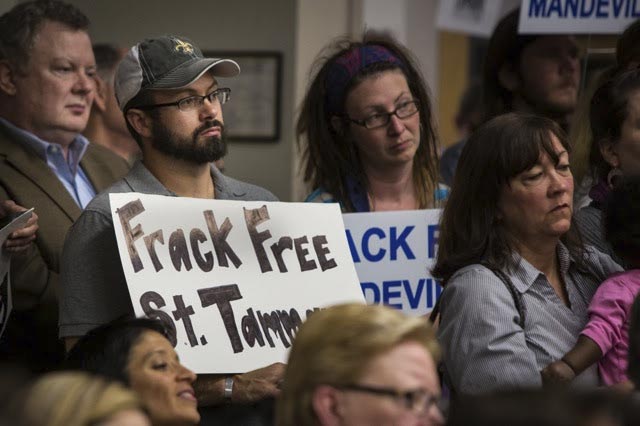 Citizens in St. Tammany Parish fill a city council meeting in May, pushing the council to fight against fracking. ©2014 Julie Dermansky
Citizens in St. Tammany Parish fill a city council meeting in May, pushing the council to fight against fracking. ©2014 Julie Dermansky
Getting a unit permit is the first step a company must take before applying for a permit to frack.
“It doesn’t permit to drill, it doesn’t permit to set up, It says if the well is drilled and is successful, this is who gets a piece of it,” Patrick Courreges, communications director for the department, told the Times Picayune.
“It is very rare that a drilling permit is declined once a unit permit is given,” Callie Casstevens, lawyer for Concerned Citizens of St. Tammany Parish, told DeSmogBlog.
The site Helis intends to frack is about 30 miles from New Orleans on top of the Tuscaloosa Marine Shale, which extends from St.Tammany Parish to beyond Baton Rouge and into Mississippi.
The Tuscaloosa Marine Shale holds an estimated seven billion barrels of oil beneath the Southern Hills Aquifer. Fracking sites along the Louisiana-Mississippi border have been growing in number since companies started producing oil via fracking.
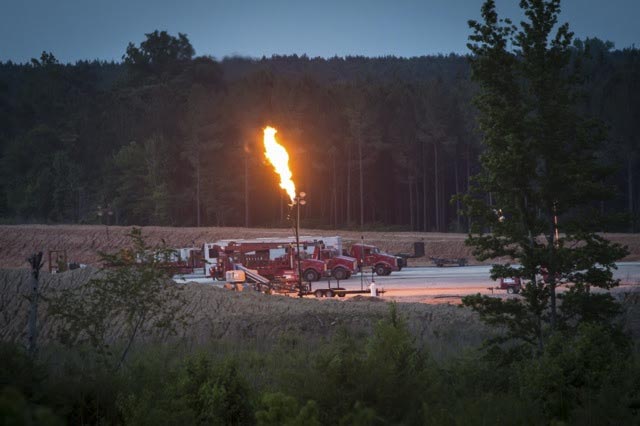 Goodrich C.H. Lewis 30-19H-1 well in production with a flare burning in Amite County, Miss. ©2104 Julie Dermansky for Jon Bowermaster’s Dear President Obama Film
Goodrich C.H. Lewis 30-19H-1 well in production with a flare burning in Amite County, Miss. ©2104 Julie Dermansky for Jon Bowermaster’s Dear President Obama Film
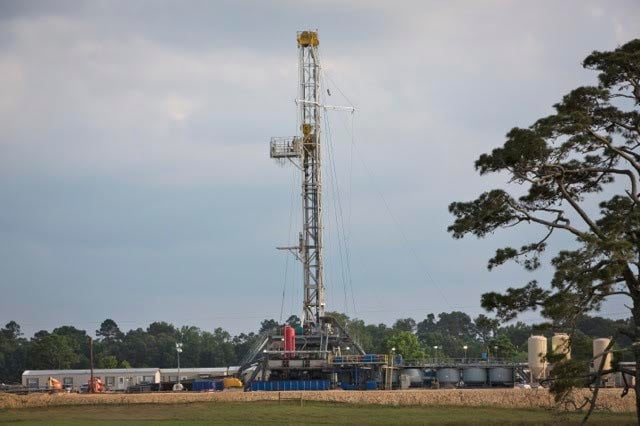 Wilkinson County, Miss., Halcon Blackstone 4H-2 well with rig in place at a hydraulic fracturing site. ©2104 Julie Dermansky for Jon Bowermaster’s Dear President Obama Film
Wilkinson County, Miss., Halcon Blackstone 4H-2 well with rig in place at a hydraulic fracturing site. ©2104 Julie Dermansky for Jon Bowermaster’s Dear President Obama Film
This fracking boom has started to change the landscape with drilling rigs, flares and heavy truck traffic on rural roads.
Plans were recently announced for the region’s first “man camp” to be built in McComb, Miss., to house the influx of short-term industry workers. The development, called “Shale Lodge,” will have 535 units to house oil workers.
Local media often fails to mention scientific studies that present evidence of water contamination and other negative impacts caused by the fracking industry.
Just a few cases in point: In Pennsylvania, the state’s Department of Environmental Protection pinpointed 243 cases of water contamination from fracking. The Environmental Protection Agency’s preliminary studies also show fracking polluted the aquifer and drinking water in Dimock, Pa. Meantime, a Cornell University study linked Oklahoma earthquakes to the fracking industry.
Yet statements by Helis Oil representatives, who claim there are no proven incidents of fracking contaminating water, are used to end local news reports. And dairy farmer Larry McDaniel, who stands to profit from fracking under his land, has become the face of the fracking industry in the Tuscaloosa Marine Shale region. With a fracksite adjacent to his farm near Kentwood, La., his cattle graze in the shadow of a large flare.
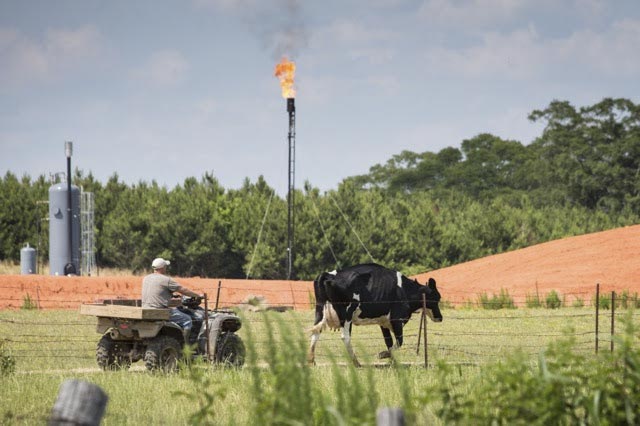 McDaniel on his dairy farm, just outside the city limits of Kentwood, La., next to a Goodrich Petroleum frack site. ©2104 Julie Dermansky
McDaniel on his dairy farm, just outside the city limits of Kentwood, La., next to a Goodrich Petroleum frack site. ©2104 Julie Dermansky
McDaniel has been featured in local media outlets saying fracking is nothing to worry about. The Times Picayune, New Orleans’ main newspaper, has repeatedly used a photo of a carefree McDaniel walking by a flare next to his farm to illustrate its stories on fracking in the region.
McDaniel “has no issues with the safety of fracking and doesn’t understand why the people in St. Tammany Parish do” reported the Picyune. But does McDaniel have enough information to make an informed decision?
McDaniel told DeSmogBlog when he first heard about fracking coming to the area he did worry his water might get contaminated. But after an old friend of his (who is a local politician) assured him fracking is safe, he decided there was nothing to worry about. While he may not have anything negative to say about the fracking industry in his backyard, he is, however, keeping track of how much milk his cows are giving, just in case that changes.
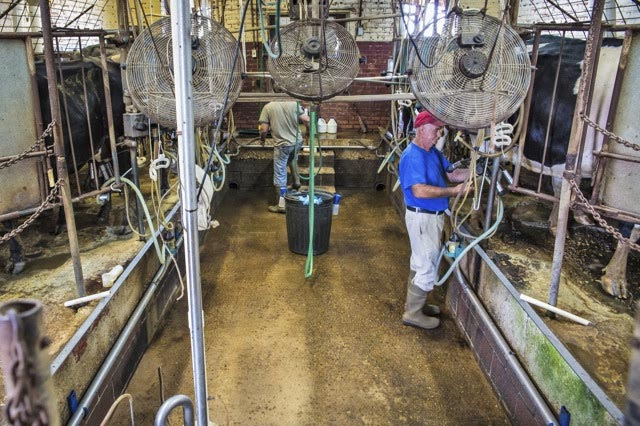 Larry McDaniel milking one of his cows at his dairy farm, just outside the city limits of Kentwood, La. ©2104 Julie Dermansky
Larry McDaniel milking one of his cows at his dairy farm, just outside the city limits of Kentwood, La. ©2104 Julie Dermansky
Despite the growth of the fracking industry in nearby parishes, St. Tammany residents are still hopeful they can keep it out of their own parish.
Helis’ proposed 600-acre fracking project still has several hurdles to overcome. For starters, the US Army Corp of Engineers declined a wetland permit Helis needs to commence work. A letter from the Corp questions whether there is another geographic region that would better suit Helis’ goals. It asks the company to consider reducing or reconfiguring the project’s footprint in the wetlands area if it is the only suitable site to minimize potential impacts.
Helis claims the holdup with the Corp is not a roadblock and plans to reapply.
“This is very routine, a normal part of the permitting process,” Helis spokesman Greg Beuerman told the Times Picayune. “It would be a mistake to overestimate the significance of this routine request.”
Dusky gopher frogs are also standing in Helis’ way. The frogs are on the endangered species list with fewer than 100 adults remaining, according to Collette Adkins Giese, with the Center for Biological Diversity. The Wildlife and Fisheries Department declared the area to be a critical habitat for the frog, challenging Helis’ right to drill. A judge ruled for the frogs, though the landowner has appealed that ruling.
Other legal battles are in the works to stop Helis from fracking, too.
The City Council of St. Tammany Parish filed a suit to get an injunction to block the Department of Natural Resources from issuing a drilling permit, alleging preexisting zoning rules prohibit fracking at the proposed site. They claim their Home Rule Charter regulations trump the state’s permitting process.
Legal precedent was recently set in Dryden and Middlefield, N.Y., where both towns won the right to ban fracking.
The St. Tammany Parish lawsuit also takes issue with a Legislative Auditor Report that states the Office of Conservation, which the Department of Natural Resources falls under, is doing an inadequate job of inspecting oil and gas wells in the state. The parish alleges the department can’t keep the parish safe from the harm the fracking industry might cause.
“Now that the unit permit was granted it is only a matter of time before Helis applies for a drilling permit at which time Concerned Citizens of St.Tammany Parish will take them to court to stop them,” Casstevens told DeSmogBlog.
“The zoning laws very clearly prevent Helis from fracking in the area they want to,” Casstevens said.
The group is not relying on the city council’s lawsuit. They are preparing to stop Helis from getting a drilling permit if the parish suit fails.
“While the granting of the unit permit is not as grave as granting a permit to drill, it serves as a reminder of the serious problems with our state laws that are designed to protect profit for a few over the general welfare of the majority.” Stephanie Houston Grey, an anti-fracking activist, told DeSmogBlog.
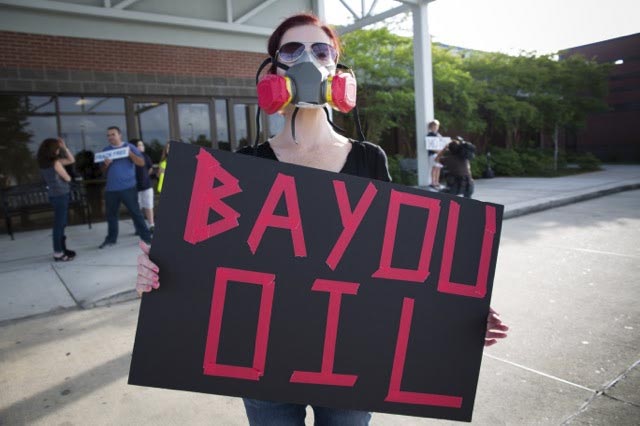 Stephanie Houston Grey at an informational meeting on fracking in Mandeville, La.
Stephanie Houston Grey at an informational meeting on fracking in Mandeville, La.
Press freedom is under attack
As Trump cracks down on political speech, independent media is increasingly necessary.
Truthout produces reporting you won’t see in the mainstream: journalism from the frontlines of global conflict, interviews with grassroots movement leaders, high-quality legal analysis and more.
Our work is possible thanks to reader support. Help Truthout catalyze change and social justice — make a tax-deductible monthly or one-time donation today.